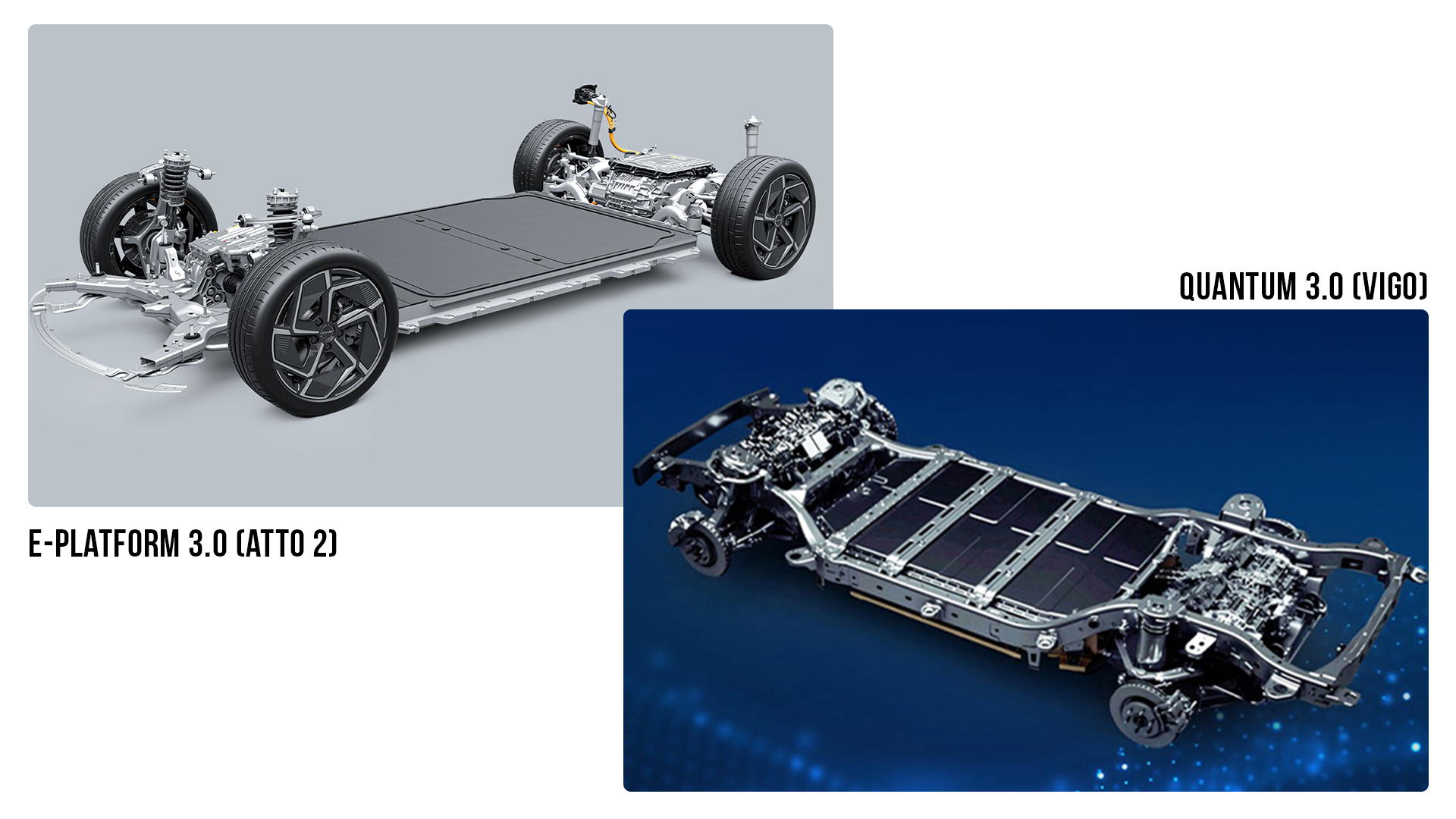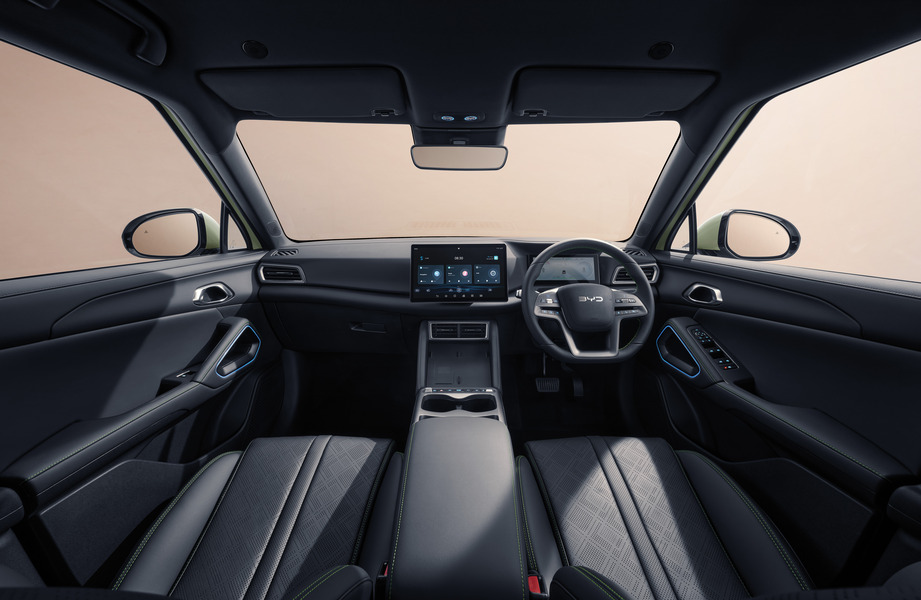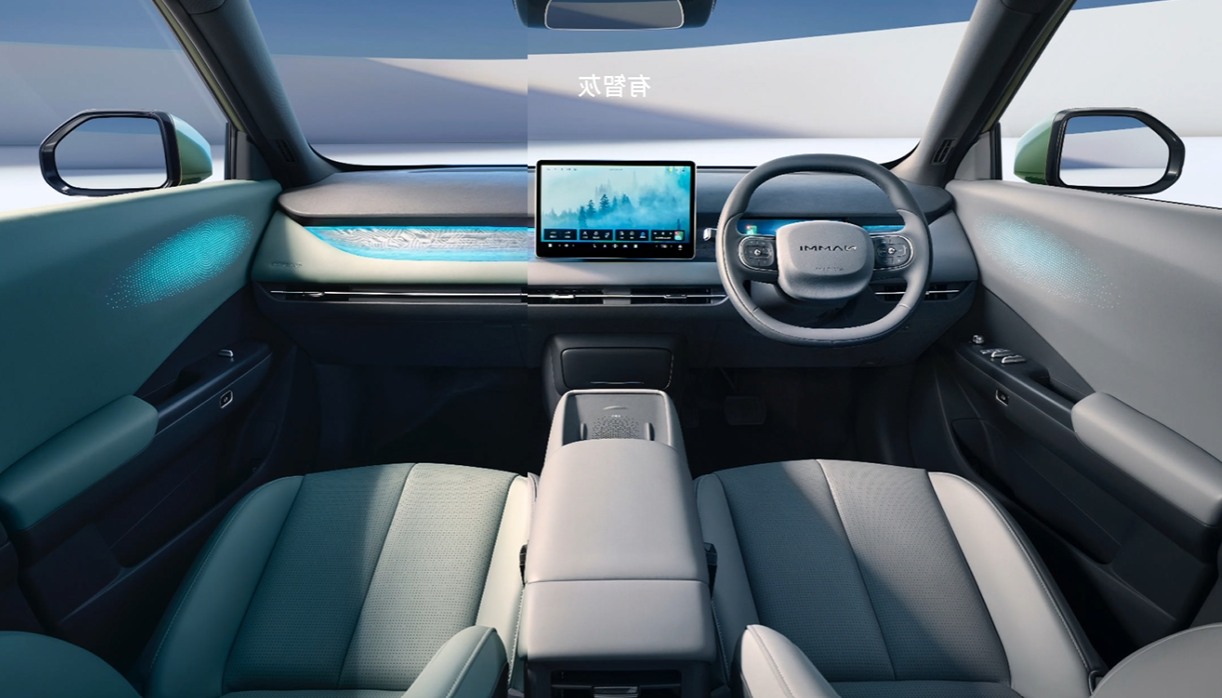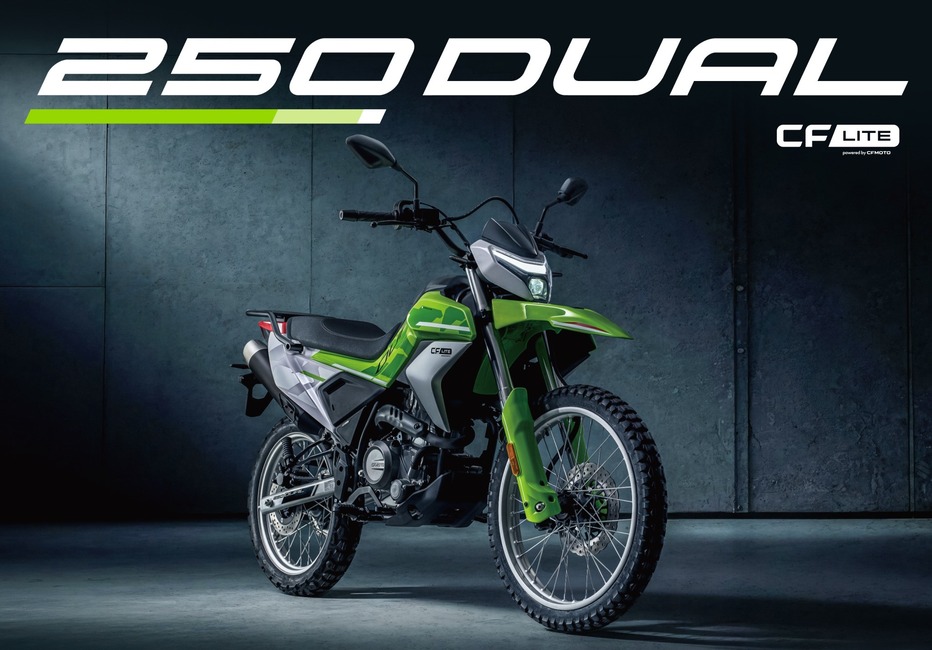Thinking about buying a compact electric SUV but stuck between the Dongfeng Nammi Vigo and the BYD Atto 2? You’re not alone. Both are fresh, promising, and loaded with features that make the decision trickier than it looks at first glance.
This is an in-depth comparison between the Nammi Vigo and the Atto 2, and this guide is here to make that choice easier, cutting through the spec sheets and marketing gloss to show you what really matters.
How do we break this down? We’ll size them up where it matters most: Pricing and Variants, Platform and Chassis, Powertrain, Design & Dimensions, Cabin and Tech, Warranty, and finally, a big verdict on which car makes more sense for you.

If you know the Chinese EV space, two names always pop up: Dongfeng and BYD. That in itself is impressive because China has more than 120 EV brands battling it out, and most of them are gasping for air. Sadly, Dongfeng falls into that struggling camp too.
Now, to be fair, Dongfeng isn’t some no-name startup. It’s a state-backed giant that has built its reputation on commercial and passenger vehicles, often through big-name joint ventures with Nissan and Honda. Reliability? Sure, that box is checked. Innovation? Not so much. While BYD sprinted ahead in electrification, Dongfeng dragged its feet and is still trying to fix its image at home, weighed down by losses.
But here in Nepal, the story feels very different. Dongfeng has been around since the days when ICE vehicles ruled the streets, and when the brand shifted gears to EVs, it actually clicked with Nepali buyers. The Nammi 01 in particular carved out a neat little fanbase.
On the other side of the ring, BYD needs no introduction. The company isn’t just China’s darling; it’s the undisputed global EV heavyweight. Affordable, high-volume, and not afraid to dabble in hybrids and even hydrogen, BYD has taken on Ford, Honda, and even Tesla and come out on top as the world’s number one EV maker. That dominance isn’t just in the numbers; it’s visible in markets like Nepal, where BYD has become a name people trust almost instinctively.
Dongfeng Nammi Vigo Vs BYD Atto 2
Which brings us neatly to the stars of today’s showdown: the Dongfeng Nammi Vigo and the BYD Atto 2. Imagine two featherweight boxers finally squaring up. When the first massive wave of EVs hit Nepal back in 2023/24, we saw BYD’s Atto 3 and Dongfeng’s Nammi 01. Both were hits in their own lanes, but they never actually clashed since their segments were too far apart, with very different price tags.
Fast forward to 2025, and the script has flipped. The Nammi Vigo launched at the NADA Auto Show, while the Atto 2 made its debut at the NAIMA Nepal Mobility Expo. This time, the gloves are off. Dongfeng is eager to show how much progress it has made in this so-called second EV wave, while BYD is flexing its tech muscle, manufacturing might, and also its hard-earned global credibility.
What makes this matchup so juicy is their philosophy. The Vigo plays the practical card, offering solid value and everyday ruggedness. The Atto 2, on the other hand, oozes confidence; it’s polished, tech-driven, and has that air of experience you can’t fake. It feels like a battle of underdog grit versus seasoned veteran.
1. Variants in Nepal and Pricing
HIGHLIGHTS:
- Dongfeng Nammi Vigo is at least Rs. 2 Lakhs more affordable than the BYD Atto 2.
- Atto 2 is available in a single variant only, while Nammi Vigo is available in two variants (E2 and E2+).
| Cars | Price in Nepal |
|---|---|
| Dongfeng Nammi Vigo | Rs. 39 Lakhs (E2) – Rs. 42 Lakhs (E2+) |
| BYD Atto 2 | Rs. 44 Lakhs |
The Nepali EV market is in the middle of a price war, and for once, that’s good news for buyers. Car brands here have long been accused of slapping on outrageous markups, but times are changing. Right now, most brands are trying to out-price each other in hopes of moving volume, and few play that game better than Dongfeng Nepal (under MAW Vriddhi AutoCorp).
We saw it with the Nammi 01, which quickly turned heads as a true value-for-money EV. Due to its affordability and offerings, it became a wake-up call for the entire segment. Carrying that momentum forward, Dongfeng has once again gone aggressive with the Nammi Vigo. The price? Well, the Dongfeng Nammi Vigo price in Nepal starts at a very tempting Rs. 39 Lakhs for its base variant E2 and goes up to Rs. 42 Lakhs for the top variant E2+. In a market where every lakh counts, those numbers alone become one of Vigo’s strongest weapons.
On the flip side, BYD Nepal (distributed by Cimex Inc.) found itself in a bit of a pricing pickle. Think about it: the Atto 3 is already on sale here, starting at a hefty Rs. 56.90 Lakhs. Then there’s the Dolphin, which used to be BYD’s entry ticket at Rs. 41.15 Lakhs (now it’s the Atto 1). Now enter the Atto 2. How do you price it without stepping on the toes of your own lineup? Too close to the Atto 3, and you kill the purpose of the “2” and “3” hierarchy. Too cheap, and you risk eating into Dolphin sales.
In the end, BYD went for the middle ground. They set the Atto 2 at Rs. 44 Lakhs. It’s positioned just above the Dolphin, which sounds logical on paper. You could argue that in-house competition sometimes sparks overall sales, but let’s be honest: comparing Dolphin and Atto 2 doesn’t make much sense unless you’re a die-hard hatchback fan who can’t tolerate SUVs. The Atto 2 is simply the better, more appealing car.
The math is simple. The Vigo undercuts the Atto 2 by at least Rs. 2 Lakhs, and in a price-sensitive segment like this, that difference is big enough to make people stop and think. For value hunters, that’s an early knockout punch from Dongfeng.
Furthermore, with the Nammi Vigo, you get two variants to choose from. The base E2 keeps things under the psychological Rs. 40 Lakh mark, which is a huge selling point. Yes, it misses a few features, but it doesn’t feel stripped down. Meanwhile, the E2+ is where the real battle is fought. With a bigger battery and better kit, it’s perfectly placed to square up against the fully loaded Atto 2.
BYD, on the other hand, takes a very different approach. You get one Atto 2 variant at Rs. 44 Lakhs. While it looks like a confident move, it doesn’t really give buyers any flexibility. In a market where choices matter in the second after the price, that feels a little tone-deaf.
So, when it comes to pricing and variants, Dongfeng Nammi Vigo walks away with a clear and decisive win.
2. Platform and Chassis
HIGHLIGHTS:
- BYD Atto 2 rides on a more advanced and capable platform than the Nammi Vigo.
- Atto 2’s chassis has an appreciable torsional rigidity that works to its advantage.
- Both cars have similar suspension setups, but Nammi Vigo has bigger wheels.
Platform
| Platform | Strengths | Weaknesses |
|---|---|---|
| Quantum 3.0 (Vigo) | Faster charging, lower cost, reliable urban focus | Lacks advanced integration like CTB, less efficient in crashes, lower global recognition |
| e-Platform 3.0 (Atto 2) | Superior safety and space thanks to CTB and Blade Battery, proven globally | Higher costs, slower charging on paper |
A platform for an EV is the very foundation of an EV. Here, both cars are built on dedicated EV platforms, but the philosophy behind each is quite different.

Now, in plain words, the e-Platform 3.0 brings more tech wizardry to the table. BYD has loaded it up with innovations like Cell-to-Body (CTB) integration and its famous Blade Battery. That means better crash safety, more interior room, and an overall futuristic setup. But, here’s the catch: with all that advancement comes a higher price tag and, if something goes seriously wrong, more complexity in repairs and thus the cost.
On the other hand, the Quantum 3.0 platform plays the “rugged and practical” card. It charges quicker, costs less, and feels very tuned to the needs of city commuters. The downside? It doesn’t carry the same global reputation, and it can’t quite match the Atto 2’s safety or space efficiency.
Chassis
| Cars | Chassis Feature | Torsional Rigidity of Chassis |
|---|---|---|
| Dongfeng Nammi 01 | Conventional | 21500 – 30000 Nm/deg |
| BYD Atto 2 | Cell-to-Body (CTB) | 40000 Nm/deg |
Coming to the chassis. Picture the chassis as the skeleton of the car, the structure that everything else clings onto. Here’s where a concept called torsional rigidity steps in. Sounds fancy, but it’s simple. Imagine holding a steel rod and trying to twist it, and it will show no signs of deformation, showing high torsional rigidity against the force that is applied. Now try the same with a plastic rod, and it will twist easily, showing low torsional rigidity. In cars, higher torsional rigidity means the chassis resists flexing under stress, which directly impacts handling, ride quality, and, most importantly, crash safety.
Materials play a huge role here too. Chassis are typically made from high-strength steel, aluminum, or sometimes even composites in high-end cars. The stronger and lighter the material, the better the results.
So, what do the numbers say? The Vigo delivers something between 21,500 to 30,000 Nm/deg, which means it can take up to 30,000 Newton-meters of torque to twist the chassis by just 1 degree. It is respectable thanks to its mostly high-strength steel build with a sprinkle of aluminum. Imagine trying to lift 3 tons of something through a 1-meter lever. The rigidity is not bad, but nothing to write home about.
The Atto 2, though, takes things up a notch with over 40,000 Nm/deg. That’s largely thanks to its Cell-to-Body (CTB) integration and aluminum-reinforced structure. Translation?
If fate ever throws these two into a crash, you’d definitely prefer being in the Atto 2.
And speaking of CTB integration, this is one of BYD’s game-changing moves. Instead of housing the battery in a separate pack bolted to the chassis, CTB literally makes the battery part of the car’s structure. This boosts rigidity and also saves space and improves efficiency. Pair that with the Blade Battery, and you get a clever blend of safety and packaging.
But the benefits don’t stop at crash protection. That extra stiffness shows up in everyday driving too. The Atto 2 feels more planted, tighter, and less prone to flexing over rough surfaces. The Vigo, by comparison, is still solid, but it leans a little softer in its suspension tuning.
So to sum it up, the Vigo’s platform and chassis do a good job of keeping things simple, affordable, and practical, but the Atto 2’s setup is clearly the more advanced package. It’s stiffer, safer, and sharper to drive, even if that sophistication comes with a higher cost and potentially pricier maintenance.
But since you can’t put a price tag on safety and also can’t not embrace a tech-centric angle, Atto 2 is the winner here!
Suspension and Brakes
| Components | Dongfeng Nammi Vigo | BYD Atto 2 |
|---|---|---|
| Suspension Setup | McPherson Strut and Torsion Beam | McPherson Strut and Torsion Beam |
| Suspension Tuning | Softer side | Stiffer side |
| Brakes | All Disc | All Disc (Front Ventilated) |
| Wheels | 17-inch (E2) and 18-inch (E2+) | 17-inch |
Both cars run with the cost-friendly combo of McPherson struts up front and a torsion beam at the rear. However, BYD tunes the Atto 2 with a sportier calibration, which gives it sharper handling. It’s not a sports car by any means, but you can feel that bit of extra confidence when taking corners.
Braking is disc all around for both, but BYD goes the extra mile by fitting ventilated discs up front. That helps cool things down faster during heavy braking, which can matter more than people realize. Wheels? The Vigo gives you 17- and 18-inch options, while the Atto 2 stays with 17-inch alloys. Sure, the Vigo’s 18s might make it look bolder on the street, but in terms of ride comfort, you won’t feel much of a difference.
Most of the parts remain the same between both cars, but the 18-inch tire options on the E2+ (which is the actual competition of the Atto 2) make a case for itself too. Moreover, even with bigger tires, E2+ claims a similar WLTP range as the Atto 2, so one up for the Nammi Vigo in this regard.
3. Powertrain
HIGHLIGHTS:
- Both cars have a similar motor capacity, but the torque figures for Nammi Vigo are unavailable.
- The Atto 2 triumphs in the battery aspect due to the Blade Battery pack.
- On paper, Nammi Vigo has higher support for DC charging and slightly better range.
Motor and Power Figures
| Cars | Motor | Max Power | Max Torque | Drive System |
|---|---|---|---|---|
| Dongfeng Nammi Vigo | 99 kW | 135 PS | N/A | Front-wheel drive |
| BYD Atto 2 | 100 kW | 136 PS | 290 Nm | Front-wheel drive |
Both cars drive the front wheels with PMSMs. Power feels predictable and easy-going, which is exactly what most buyers in this segment want.
The Vigo runs a 99 kW motor, while the Atto 2 edges slightly ahead with 100 kW. Torque is trickier to compare. Official figures for the Vigo are missing, though the Chinese version (Nammi 06) ran a 135 kW motor with 290 Nm. With the detuned 99 kW unit, we can only guess. For now, let’s call it even.
But what’s not even is the very drive system itself. The Atto 2, reflecting on the R&D might of BYD, has an 8-in-1 integrated powertrain, which makes the overall drive system compact, yes, but it also enhances the efficiency of the drive system itself. Moreover, such drive systems are compact and light which means more room for utilization.
The Atto 2 does reveal its sprint stats: 0–100 km/h in around 9 seconds and a top speed of about 150 km/h. Vigo hasn’t published numbers yet, which does it no favors in a head-to-head comparison. Just for reference, the original 135 kW motor model that we talked about could achieve 150 km/h of top speed.
Battery
| Vehicle | Battery Capacity | Battery Chemistry | Drive Range (WLTP) |
|---|---|---|---|
| Nammi Vigo | 44.94 kWh (E2) – 51.87 kWh (E2+) | Lithium Iron Phosphate (LFP) | 300 km – 350 km |
| BYD Atto 2 | 51.13 kWh | Lithium Iron Phosphate (LFP) | 345 km |
Both the Nammi Vigo and the BYD Atto 2 run on LFP chemistry, but they take very different approaches. The Vigo sticks with a conventional LFP pack. It is safe, reliable, and affordable, but it doesn’t exactly scream innovation. You get the job done, but nothing is exciting about it.
The Atto 2, on the other hand, goes the extra mile with BYD’s signature Blade Battery featuring CTB integration. Same LFP chemistry, but packaged smarter. This design makes the battery slimmer, stronger, and safer. Couple that with BYD’s refined Battery Management System, and you get better thermal control and higher overall efficiency. It’s like comparing a solid home-cooked meal with a Michelin-star dish. Yes, both fill you up, but one leaves a lasting impression.
Looking at these numbers, the real battle is between the top Vigo variant, the E2+, and the standard Atto 2. So how do these packs translate into driving range?
The base Vigo (E2) with its 44.94 kWh pack delivers around 300 km of WLTP range, which is decent, solid, and nothing to complain about. Step up to the E2+ with 51.87 kWh, and you get a claimed 350 km WLTP range. That’s only a small jump over the base variant, leaving you wishing for a bit more from the top-of-the-line Vigo.
The Atto 2, meanwhile, comes with a WLTP range of 345 km, which might look slightly behind the E2+ on paper. But there’s a catch. Thanks to its smarter battery packaging and refined management system, the Atto 2’s range is more likely to be achievable in real-world, mixed-driving conditions and maintained consistently over time. So while the Vigo’s numbers look a little flashier, the Atto 2 delivers a more reliable experience day in and day out.
Charging
Charging is where things get interesting. The official times are almost always measured under perfect lab conditions: around 20–25°C, stable grid voltage, and an ideal charger. Take these numbers as a guide rather than gospel.
| Vehicle | State of Charge (SOC) | AC Charging (~7 kW) Time |
|---|---|---|
| Nammi Vigo | 0 – 100% | 7 hours (E2) – 8 hours (E2+) |
| Atto 2 | 0 – 100% | 8 hours |
No surprises here. Both cars converge around the same overnight charging time. Now, let’s take a look at the DC Charging capabilities:
| Vehicle | Max DC Support | 20–80% Time |
|---|---|---|
| Nammi Vigo | 167 kW (only for E2+ variant) | 18 minutes |
| Atto 2 | 82 kW | 25 minutes |
On paper, the Vigo looks like it smashes the Atto 2 with a 167 kW peak rate. But let’s be honest, Nepal’s charging infrastructure can’t exploit that kind of speed yet. Fast charging is exciting, but it doesn’t automatically make the Vigo better. That huge peak is achieved by the Quantum 3.0 pack’s focus on high-rate LFP cells tailored for developing markets. It’s more about potential than practicality.
The Atto 2, with its more modest 82 kW peak, reflects BYD’s deliberate design philosophy of the charging dynamics. By limiting the peak, BYD avoids overstressing the integrated CTB structure, which improves long-term safety, battery health, and reliability. But BYD in this case seems to be playing a little too safe, as the peak charging capability could definitely have been more optimized. That aside, in practice, this means the 345 km WLTP range is closer to what you might actually see on the road, even under mixed driving conditions, compared to the Vigo’s 350 km claim on the same WLTP scale.
To put it in perspective, Nammi Vigo’s smaller sibling, the Nammi 01, had a WLTP range of 317 km (top variant) and delivered around 300 km in optimistic real-world conditions, dropping closer to 280 km if you push it hard. It’s reasonable to expect a similar real-world range from the Vigo. Meanwhile, the Atto 2’s range is more consistent and less prone to drop-offs, thanks to its smart thermal and battery management.
In the end, when it comes to battery design, reliability, and achievable range, the BYD Atto 2 takes the crown. It might not flash the fastest DC numbers on paper, but it delivers performance you can count on day after day.
4. Design and Dimensions
HIGHLIGHTS:
- Nammi Vigo offers some fresh design angle while Atto 2 sticks to its roots.
- Ground clearance for the Nammi Vigo and Atto 2 is 190 mm and 200 mm, respectively.
- Both being compact SUVs have similar kind of dimensions, but Vigo has a longer wheelbase.
Let’s talk design. Now, beauty is always in the eye of the beholder, so we’re not here to declare a winner based on which car looks prettier. Instead, we’re looking at the philosophy behind each design and what it tells you about the car’s character.
Starting with the Nammi Vigo, its design concept is called the “Fun Rubik’s Cube.” Think playful, modular, and youthful. Every angle and curve hints at a personality that is light, clean, and just a bit cheeky. The boxy shape might seem conventional at first, but it works surprisingly well. It’s the kind of car that looks approachable and energetic, and that daring approach makes it stand out in a crowd.
The BYD Atto 2 takes a different but the same route with BYD’s signature “Dragon Face” design. Inspired by Chinese mythology, this is about power, agility, and good fortune. Literally, it’s meant to resemble a dragon’s head.
In reality, the Atto 2 delivers the first two: it feels capable and nimble for its class, though good fortune might cost you Rs. 44 Lakhs. Whether the luck flows after purchase is up to you to test. But, compared to the Atto 3, the Atto 2 might feel a bit leaner, which may not appeal to everyone. In contrast, Vigo’s bold design choice is more likely to grab attention and spark conversations.
Exterior Colors include Ski White, Harbour Grey, Cosmos Black, and Breeze Green for the Atto 2, while the Nammi Vigo offers White, Grey, Orange, Green, and Beige.
Dimensions
| Measurement (mm) | Dongfeng Nammi Vigo | BYD Atto 2 |
|---|---|---|
| Length | 4306 mm | 4310 mm |
| Width | 1868 mm | 1830 mm |
| Height | 1654 mm | 1675 mm |
| Wheelbase | 2715 mm | 2620 mm |
| Ground Clearance | 190 mm | 200 mm |
| Boot Space | 500-liter | 380-liter |
Dimensionally, these two are quite close. The Atto 2 stands a bit taller, giving it a notable 200 mm ground clearance. The Vigo comes in at a solid 190 mm, which is more than enough to tackle the city’s notorious potholes and rough stretches.
In width, the Vigo slightly edges out the Atto 2, hinting at a tiny advantage in the rear-seating area. For city driving and tight corners, both cars handle well. The Atto 2 has a turning radius of 5.2 meters, and the Vigo is right there at 5.3 meters. In everyday driving, you won’t notice the difference.
The official distributors haven’t shared those numbers in any shape or form, which is a bit odd considering how important weight is for an EV’s performance, efficiency, and even handling. Still, we did some digging. The original Nammi Vigo, the one that comes with the bigger 135 kW motor, tips the scales somewhere between 1526 kg and 1550 kg, depending on which battery pack you choose.
On the other side, the BYD Atto 2 isn’t too far off either, sitting at around 1540 kg. So, on paper, both cars belong in the same weight class. But these numbers aren’t officially confirmed for the Nepali market. That means you should treat them less like gospel and more like gossip. Until they put it out officially, though, we’re left to play detective.
Space is another area where dimensions matter. The Vigo impresses with a 500-liter boot that expands to 1040 liters, plus a 70-liter front trunk. Its longer wheelbase (2715 mm Vs. 2620 mm) also translates to better rear legroom and even a clever “bed mode” when the front seats fold down. Also, you can extend the boot floor of Vigo out for a sitting or keeping your stuff during any outdoor activities – quite handy!
The Atto 2, on the other hand, starts with a 380-liter boot but expands to 1320 liters, slightly surpassing Vigo’s maximum capacity. Both cars manage cabin storage smartly with glove boxes, cup holders, and bins, so you won’t feel short on everyday practical storage.
So, when it comes to exterior dimensions, both cars are evenly matched. No complaints here. The choice boils down to whether you prefer the playful and boxy personality of the Vigo or the sleek, myth-inspired elegance of the Atto 2.
5. Cabin and Tech
HIGHLIGHTS
- Both cars go with that “minimal” theme but Atto 2 oozes better quality in the interior.
- Feature-wise, both cars go toe-to-toe with only one or two features here and there.
Here’s a quick list of available features in the BYD Atto 2 and Dongfeng Nammi Vigo.
| Feature | BYD Atto 2 | Nammi Vigo |
|---|---|---|
| Seat | Vegan Leatherette | Leatherette |
| Seat Functions | Ventilated front seats | Ventilated/Heated/Memory driver seat |
| Steering | Single-spoke with mounted controls | 3-Spoke with mounted controls |
| Infotainment Display | 12.8-inch rotating touch screen | 12.8-inch touch screen |
| Instrument Cluster | 8.8-inch digital | 8.8-inch digital |
| Wireless Charger | Yes (Plus Ventilated) | Yes |
| Speakers | 8 | 6 |
| Glass Roof | Yes | Yes (E2+ only) |
| Climate Control | Yes | Yes |
| Rear AC Vents | Yes | No |
| Rear Hand Rest and Cupholders | Yes | Yes |
| Read Central Head Rest | Yes | Yes |
| Interior Colors | Black only | White, Silver, Grey, Black |
| Connectivity | Wireless & wired Android Auto (AA)/ Apple Car Play (CP) | Wireless CP |
| USB Ports | Type A & C (Front and Rear x 2) | Type A & C (Front and Rear x 2) |
Step inside either the Nammi Vigo or the BYD Atto 2, and you’ll immediately pick up on a familiar theme that runs across most Chinese EVs: that clean, minimal interior tone. At first glance, both cabins seem to be cut from the same cloth. You get leatherette seats, a mix of soft and hard plastics, and a big infotainment screen sitting proudly at the center of the dashboard.

Both cars pack a big 12.8-inch infotainment screen, but the Atto 2 adds its own party trick: that rotating display. It might sound like a gimmick at first, but in practice, it’s surprisingly handy, switching between portrait and landscape depending on whether you’re navigating or bingeing on CarPlay apps. Resolution is solid on both, though BYD has built a reputation for its sharp, high-contrast panels. So, if past models are anything to go by, you can expect the Atto 2 to look just a bit more polished.
On the performance side, we know the Nammi Vigo runs a Qualcomm Snapdragon 6125 under the hood of its infotainment unit. The Atto 2’s chip hasn’t been confirmed yet, but judging from how BYD handles responsiveness in its other cars, it’s safe to expect quick load times and minimal lag. In other words, scrolling, swiping, and app switching won’t have you tapping your fingers in frustration. The Vigo plays it safe with proven hardware, while the Atto 2 leans on polish and small but clever touches. If tech is your thing, BYD clearly wants you to notice.
In front of the driver, there’s an 8.8-inch fully digital instrument cluster in both cars, while the center console stretches forward to house cupholders, a wireless charging pad, and even a little nook for your phone. Add in a flat-bottom steering wheel with mounted controls, power-adjustable seats, a glass roof, multiple charging ports, and a bunch of speakers, and the checklist looks more or less identical.
But that’s just the surface read. Dig a little deeper, and the story starts to change. The Atto 2 quickly separates itself by feeling more premium, even if only slightly. Its vegan leather seats are more upscale, the cabin feels brighter and roomier thanks to its CTB flat floor, and refinement is a notch above as the noise, vibration, and harshness are better managed here. Dedicated AC vents aimed at rear passengers also add to the comfort, and the soft-touch materials are spread across more touchpoints, giving it a genuinely plush feel that the Vigo can’t quite match.

Then there’s the infotainment screen. Both cars feature a similar size, but the Atto 2 adds a neat party trick: it can rotate between portrait and landscape modes. Portrait works brilliantly for navigation, while landscape is perfect for Netflix binges when you’re waiting in the car. Clever, and a little fun too.
Despite having a shorter wheelbase than the Vigo (by a good 95 mm), the Atto 2 manages to offer just as much legroom, which feels like some packaging wizardry at work. To top it off, you get an 8-speaker audio setup, compared to the Vigo’s 6-speaker system. That said, the Vigo does fire back with its external speakers, which may not be as classy but do add a quirky edge if you’re into street-side music vibes.
Now, to give the Vigo some credit, it doesn’t try to out-premium the Atto 2, and that’s not really its goal anyway. Vigo is pitched as a car for younger buyers who want affordability and practicality with a hint of style, not a luxury-laden cocoon. And in that space, it makes smart choices. For instance, the driver’s seat gets heating, ventilation, and even memory functions, something the Atto 2 surprisingly skimps on. Over on the Atto, you only get ventilation. So yes, while Vigo might lose the material and refinement battle, it fights back with features that actually make day-to-day driving a little more easier. Plus, there are colors to choose for in the interior, i.e., White, Silver, Grey, and Black.
In the end, if you’re after plushness and polish, the Atto 2 definitely takes the cake.
But if you’d rather save a bit of cash while still enjoying a good enough cabin that’s a youth-friendly cabin, the Vigo makes a strong case without pretending to be something it’s not.
6. Safety
HIGHLIGHTS:
- Atto 2 comes with a more sturdier chassis than the Nammi Vigo.
- Both score well in active safety, but Atto 2 adds superior passive + active safety equipment overall.
When it comes to safety, the Atto 2 really plays its trump card: that rock-solid structure. With torsional rigidity rated at 40,000 Nm/deg, the chassis is tough enough to shield passengers in a crash and tight enough to make the car feel sharper and more planted on the road.
In other words, it will not only protect you but it will also help you avoid sticky situations in the first place. The Nammi Vigo does hold its ground with 21,500–30,000 Nm/deg, which is decent for its class. But compared to the Atto 2, it feels a bit less robust. Safe for the daily grind? Absolutely. Built for long-term toughness and crash management? The Atto 2 takes that crown. And, considering both are family-centric SUVs, this particular aspect adds a diamond on top of that crown.
Now, equipment-wise, both cars throw in a solid safety arsenal. Each one comes with six airbags, ISOFIX mounts, and the usual suite of braking and stability aids. The Atto 2 flexes its CTB-integrated structure with aluminum reinforcements, while the Vigo keeps things conventional with a reinforced high-strength steel body.
Here’s a quick list of the available safety features in the Nammi Vigo and Atto 2:
| Category | BYD Atto 2 | Dongfeng Nammi Vigo |
|---|---|---|
| Passive Safety Equipment | 6 Airbags, Rigid CTB-integrated safety cell, High-strength steel + Aluminum reinforcements | 6 Airbags, Reinforced body structure with high-strength steel |
| Active Safety Equipment | *TCS, *ESC, *HAC, *BA, *TPMS, *ADAS, Adaptive cruise control, 360 degree cam, Front and rear parking radars | *TCS, *ESC, *HAC, *BA,*TPMS, *ADAS, Adaptive cruise control, 360 degree cam, Front and rear parking radars |
*ADAS – Advanced Driver Assistance System, *ESC – Electronic Stability Control, *TCS – Traction Control System, *HAC – Hill Assist, Control, *BA – Brake Assist, *TPMS – Tire Pressure Monitoring System
On paper, the Vigo does well to match the Atto 2 almost feature-for-feature, even throwing in adaptive cruise control. But here’s the catch. Hardware is only half the story. The real difference shows up in execution. BYD has years of experience fine-tuning ADAS systems, and the Atto 2 benefits from that maturity.
The Vigo’s ADAS, while fairly comprehensive, comes from a younger brand that’s still finding its footing. We’ve already seen this on the Nammi 01, where the ADAS felt ambitious but sometimes rough around the edges. The features were there, but the polish wasn’t.
In conclusion, the Atto 2 scores higher on passive safety thanks to its tougher, smarter structure, while both cars pack plenty of active safety features. But if you value consistency and confidence in the tech that’s watching your back, the Atto 2 comes across as the safer bet.
7. Warranty and After Sales
This is where BYD lands a knockout punch. The Atto 2 comes with an industry-leading 10-year (or 200,000 km) warranty on the battery and motor. Vigo counters with 8 years (or 160,000 km), which is respectable but not class-leading. Add BYD’s established after-sales network in Nepal, and the trust factor leans heavily toward the Atto 2.
Final Verdict: Nammi Vigo Vs BYD Atto 2
So, which one should you pick?
If you are the type who counts every rupee and loves squeezing maximum value, the Nammi Vigo makes a strong case. It undercuts the Atto 2 on price, offers more flexibility with variants, gives you bigger storage, and even shows off faster DC charging numbers. For buyers who just want a solid, feature-packed EV under Rs. 40–42 Lakhs, the Vigo is hard to argue against.
But if you play the long game and value peace of mind, the BYD Atto 2 is the safer bet. Its Blade Battery with CTB integration is world-class, the build quality feels more premium, and that 10-year warranty is unmatched in this segment. Add BYD’s stronger after-sales network, and you get a car that may cost more upfront but promises less hassle over the years.
In short, the Vigo is the smart underdog punching above its weight, while the Atto 2 is the polished heavyweight that wins on trust and refinement. The choice comes down to what matters more to you: stretching your budget for long-term confidence, or saving money now for a feature-rich ride.
After checking both cars inside out, the highs, the lows, and the in-betweens, it’s the BYD Atto 2 that comes out on top. In most areas, it leads the way, and where it doesn’t, it holds its ground. The only real gripe is the higher price tag, and while that sting is there, the overall package makes it feel worth stretching for. The Atto 2 isn’t flawless by any means, but in this matchup, it takes the win.
-
CFMoto 250 Dual in Nepal: Can It Outplay the XR 190L and XPulse 210?HIGHLIGHTS CFMoto 250 Dual price in Nepal is expected to be below Rs. 6 Lakhs.…
-
These are the Best Tablets in Nepal at Every Price Range!Tablets are such a weird product! They aren’t phones, they aren’t laptops. Heck! They aren’t…
-
ZTE Nubia V80 Design Launching Soon in Nepal: A Budget iPhone Lookalike ReturnsHIGHLIGHTS The ZTE Nubia V80 Design price in Nepal could be Rs. 18,999 (8/256GB). The…














